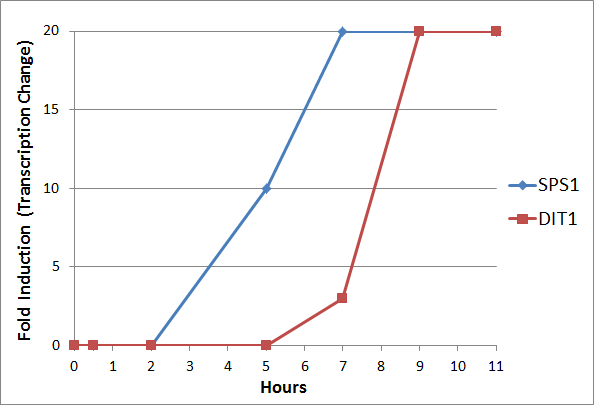Blitvak Week 7
From LMU BioDB 2015
Revision as of 22:41, 18 October 2015 by Blitvak (Talk | contribs) (added response to question 11, p.120)
Reading Questions
- (Question 5, p. 110) Choose two genes from Figure 4.6b (PDF of figures on MyLMUConnect) and draw a graph to represent the change in transcription over time. You can either create your plot in Excel and put the image up on your wiki page or you can do it in hard copy and turn it in in class.
- (Question 6b, p. 110) Look at Figure 4.7, which depicts the loss of oxygen over time and the transcriptional response of three genes. These data are the ratios of transcription for genes X, Y, and Z during the depletion of oxygen. Using the color scale from Figure 4.6, determine the color for each ratio in Figure 4.7b. (Use the nomenclature "bright green", "medium green", "dim green", "black", "dim red", "medium red", or "bright red" for your answers.)
- (Question 7, p. 110) Were any of the genes in Figure 4.7b transcribed similarly? If so, which ones were transcribed similarly to which ones?
- Gene X and Gene Y were somewhat similarly transcribed since they were both first up-regulated (at 3 hours) and then later heavily down-regulated (at 9 hours). At one hour, there existed no changes for both genes; at 5 hours, gene Y was slightly down-regulated while gene X remained the same. Compared to gene X, gene Y was also showed a higher degree of up-regulation and down-regulation.
- (Question 9, p. 118) Why would most spots be yellow at the first time point? I.e., what is the technical reason that spots show up as yellow - where does the yellow color come from? And, what would be the biological reason that the experiment resulted in most spots being yellow?
- Most spots would be yellow at the first time point because there is no change in gene expression, yet (equal expression in the, red, experimental group and the, green, control group); the gene regulatory response to the different conditions is not immediate (takes some time for the regulatory processes to react to the different conditions). Technically speaking, the yellow color is the result of there being equal (or near equal) amounts of green and red fluorescing DNA. Biologically speaking, the reason that the experiment resulted in mostly yellow spots would be because the gene expression for most genes did not change; the gene expression of only a few genes changed because that is all that is necessary for/related to the new conditions.
- (Question 10, p. 118) Go to the Saccharomyces Genome Database and search for the gene TEF4; you will see it is involved in translation. Look at the time point labeled OD 3.7 in Figure 4.12, and find the TEF4 spot. Over the course of this experiment, was TEF4 induced or repressed? Hypothesize why TEF4’s change in expression was part of the cell’s response to a reduction in available glucose (i.e., the only available food).
- TEF4 was repressed during the course of this experiment, which is indicated by the green color of the spot that corresponds to that gene. TEF4 might have been repressed because the process of translation requires energy, and there is a need, during times of low available food (glucose), to conserve energy.
- (Question, 11, p. 120) Why would TCA cycle genes be induced if the glucose supply is running out?
- In response to the glucose supply running out, the gene regulatory system reflects an anticipation of starvation conditions; genes related to the TCA cycle would get up-regulated in order to ensure that more components (like pyruvate) move towards the TCA cycle instead of other cycles/pathways (while the other cycles that employ those same components, would get down-regulated). Genes involved in the production of energy storage molecules (sugars) are also up-regulated, and, in conjunction with an up-regulation of the TCA cycle, lead to increased levels of energy storage. In short, the TCA cycle genes are induced in order to better adapt the yeast for possible starvation conditions.
- (Question 12, p. 120) What mechanism could the genome use to ensure genes for enzymes in a common pathway are induced or repressed simultaneously?
- (Question 13, p. 121) Consider a microarray experiment where cells deleted for the repressor TUP1 were subjected to the same experiment of a timecourse of glucose depletion where cells at t0 (plenty of glucose available) are labeled green and cells at later timepoints (glucose depleted) are labeled red. What color would you expect the spots that represented glucose-repressed genes to be in the later time points of this experiment?
- (Question 14, p. 121) Consider a microarray experiment where cells that overexpress the transcription factor Yap1p were subjected to the same experiment of a timecourse of glucose depletion where cells at t0 (plenty of glucose available) are labeled green and cells at later timepoints (glucose depleted) are labeled red. What color would you expect the spots that represented Yap1p target genes to be in the later time points of this experiment?
- (Question 16, p. 121) Using the microarray data, how could you verify that you had truly deleted TUP1 or overexpressed YAP1 in the experiments described in questions 8 and 9?
Brandon Litvak
BIOL 367, Fall 2015
| Weekly Assignments | Individual Journal Pages | Shared Journal Pages |
|---|---|---|
|
|
|
|

